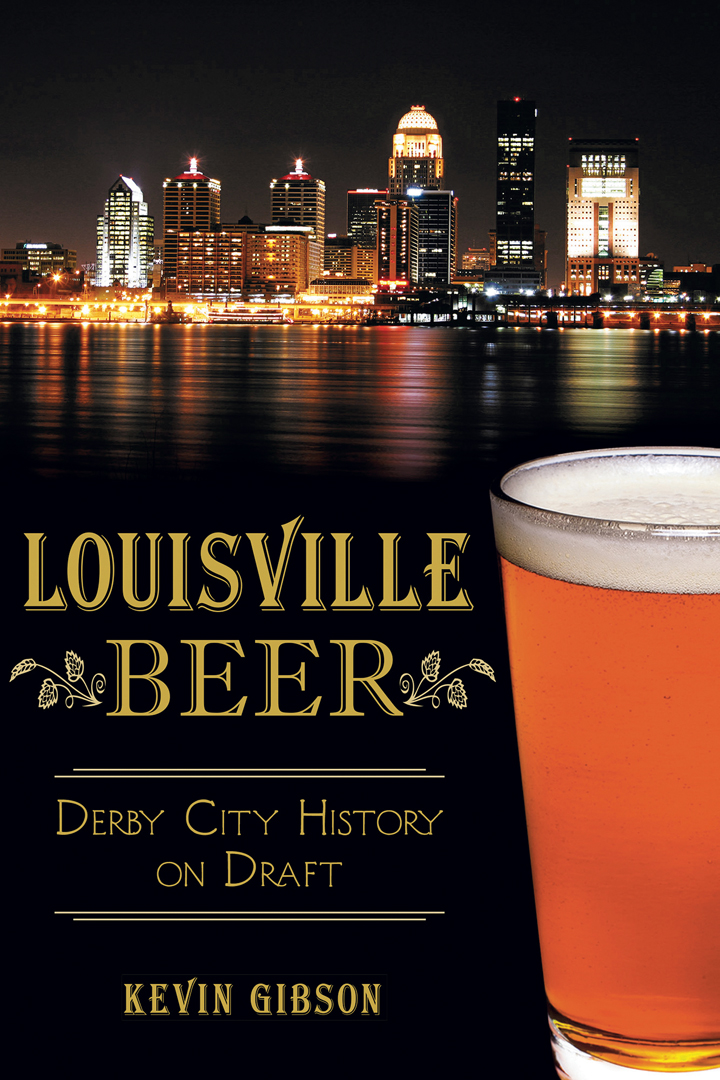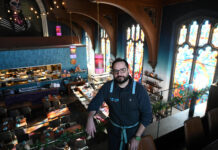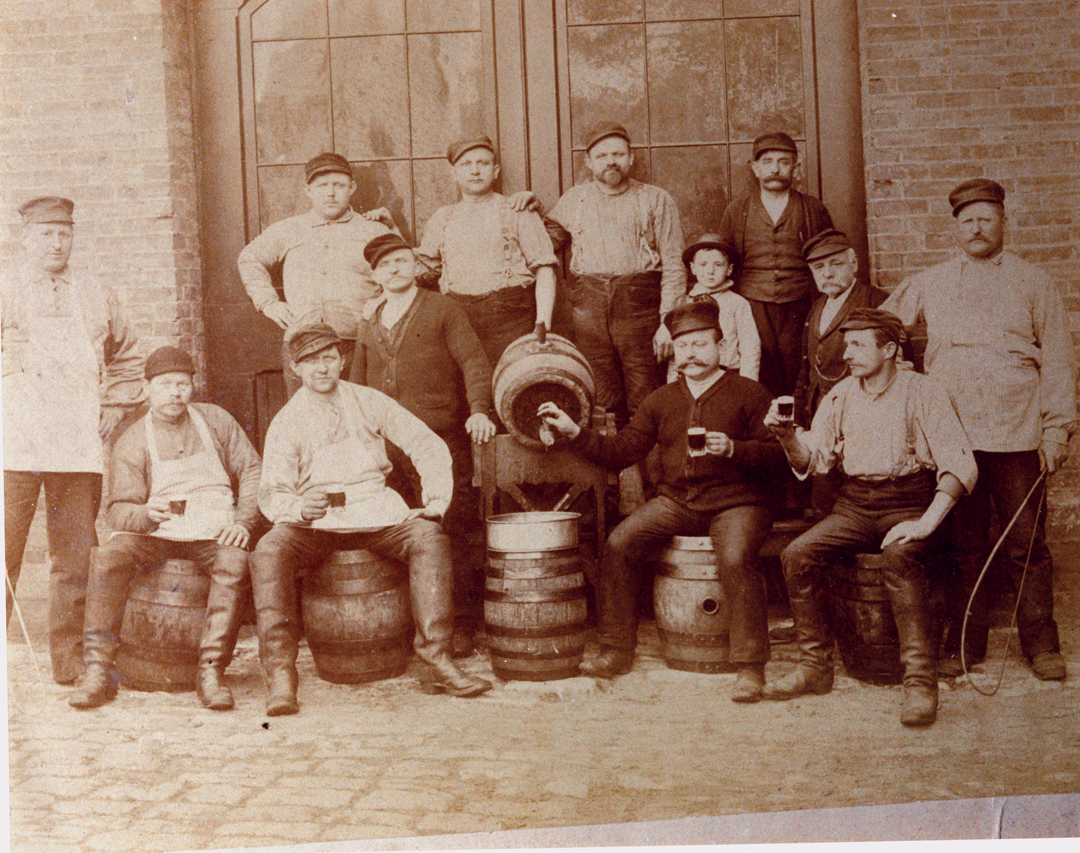“Anyone who has groped among the dark beer dungeons which lie for a number of deep streets under Phoenix Hill, would scarcely imagine while in those dark, chilly caves, that far above him the place would grow into such an efflorescence of beauty, fashion and brightness.”
From 1865 until 1919, Phoenix Hill Park was Louisville’s foremost beer garden, except that beer and sausages weren’t the only attractions. The park was a multi-tasking entertainment Mecca (or Munich), boasting a bandstand, bowling alley, dance hall, skating rink and velodrome, and even the fabled Hofbrauhaus itself never managed so many thirst-inducing brand extensions atop its lagering cellars. For a half century prior to the advent of Prohibition, Louisville was a town of brewing renown, and beer kept pace with bourbon in the popular imagination. It’s true that Prohibition smashed the tablets, but even without the villainy of legislated abstention, beer’s place in local culture would have changed with passing years, as norms brought to the area by German immigrants became exposed to the diffusion of the American melting pot.
It’s a fascinating story, and local writer Kevin Gibson tells it very well in his new book, “Louisville Beer: Derby City History on Draft,” an account of beer’s rise, fall and resurgence in Louisville.
Gibson writes chronologically, beginning with Louisville’s earliest Anglo-Scottish ale traditions and concluding with today’s local craft beer boom. He detours briefly to consider the brewing process and beer styles, including our indigenous Kentucky Common and the Bock beers that once proliferated in springtime.
Wisely, Gibson does not detour from the beer tale at hand to attempt a detailed examination of the alpha acid content of bittering hops used in pre-Prohibition Pilsner. Rather, he describes the experience of Louisville beer in everyday life, and documents how it has changed over time.
In post-Colonial years through the early 1800s, beer generally was of secondary consideration to cider and whisky – until substantial numbers of Germans began coming to this area following the revolutions of 1848. They brought the formative technological underpinnings of lager brewing, which was poised to explode into a worldwide phenomenon.
According to Gibson, this 19th-century German diaspora tended to be more selective and organized than we might assume. Upon reaching their ultimate destinations in America, immigrants were absorbed into full-scale communities. Cultural proclivities included beer as an integral part of daily nutrition and social life, and consequently, some Louisville neighborhoods were as German as the Fatherland itself.
There were dozens of small breweries, and beer was consumed voluminously – at breakfast (soup with stale beer as stock); in the workplace, where “small” beer was preferred to mere water; and at night, when men gathered over platters of pork and dumplings to soothe the rigors of the day.
However, there was another viewpoint. Precisely because these new arrivals enjoyed their tankards, it was a natural next step for “Know Nothing” nativists to orchestrate a backlash, conflating beer with the evils of immigration, and incorporating pre-existing xenophobia into a program of opposition.
When anti-immigrant sentiments merged with fundamentalist Protestantism, they found a ready ally in do-gooder “progressive” groups espousing the imperative of societal improvement, and a full-fledged temperance movement was born.
It was Carrie Nation-building: God says drinking is bad, and just look at all those non-English speaking, beer-drinking immigrants taking our jobs; what’s more, if we’d all work sober and harder, we’d be more efficient cogs of capitalism – and that’s the real American religion. Cue hatchets flying, mostly against barroom furniture, but sadly, sometimes aimed at people, too.
The period 1933-1977, between Repeal to Falls City Brewing Company’s closure, is critical, and Gibson does not neglect it.
During the 1930s and 1940s, with Prohibition over and America emerging from World War II as the planet’s economic powerhouse, it seemed that a local brewing renaissance was happening. Fehr’s, Oertel’s and Falls City rose from “near” beer to regional prominence almost overnight. The smaller neighborhood breweries were gone, and Louisville’s Big Three profited.
But it was an illusion. By the mid-1960s, the verdict already was becoming clear: A regional-sized production brewery in a city like Louisville enjoyed preferential economies of scale when compared to the extinct smaller operators, but larger entities higher up the beer chain could commoditize beer even more efficiently than the regionals. The market was about price point, and the higher end didn’t yet exist apart from a handful of imports.
Budweiser and Miller emerged victorious, and Louisville brewing ceased to exist. It didn’t return until 1990, when David Pierce brewed a legal batch of pale ale for the long defunct Charley’s Restaurant on Main Street. Pierce helped open the Silo Brewery in 1992, and manned the brewhouse for Bluegrass Brewing Company from 1993 through 2009. The contemporary brewing era had begun, and it remains vibrant.
“Louisville Beer” is especially useful in providing descriptive attention to the two decades elapsing since brewing’s return. What’s more, this section of Gibson’s narrative offers context, and the inescapable conclusion is that the present-day craft constitutes a revolution all its own, rather than a restoration of past glories.

The late Tony Judt had this to say about the historian’s purpose: “You cannot invent or exploit the past for present purposes.” In this sense, although previous epochs of Louisville beer share similarities, they were very different from what craft beer has become.
Impressive annual growth aside, craft brewing in the year 2014 remains a minority-driven, premium-priced, niche phenomenon, not the universal cultural norm of the pre-1900 period, when Louisville brewing was genuinely localized during a time when being a locavore almost was a default condition.
Granted, beer and food came to Louisville from elsewhere in America, as originally conveyed on river boats, and later in railway cars. At times, beer came from very far away; witness a Louisville hotel restaurant menu in 1857 boasting French wines and Guinness Stout from Dublin. Nonetheless, most beer produced by 19th century Louisville neighborhood breweries was consumed within the same neighborhood.
Furthermore, no Louisville craft brewer today can lay claim to the market hegemony of Fehr’s, Oertel’s and Fall City following Prohibition’s end.
Judt again: “A history book — assuming its facts are correct — stands or falls by the conviction with which it tells its story. If it rings true to an intelligent, informed reader, then it is a good history book.”
“Louisville Beer” passes this test. The strength of Kevin Gibson’s narrative lies in his ability to convey the way it felt to drink beer in Louisville at various times in the past.
Details valued today mattered less back then. Being a beer drinker in Louisville in the year 1890 was not about checking-in, or chasing, trading and hoarding.
Rather, it likely involved a healthy dollop of ethnic German-ness; came accompanied with a good bit of child-like mystery as to the process; and resulted in prodigious intake in the relative absence of plasticized tap water, smoothies and teeth-corroding “soft” drinks.
This Christmas, consider a good book to go along with the good beer.

























